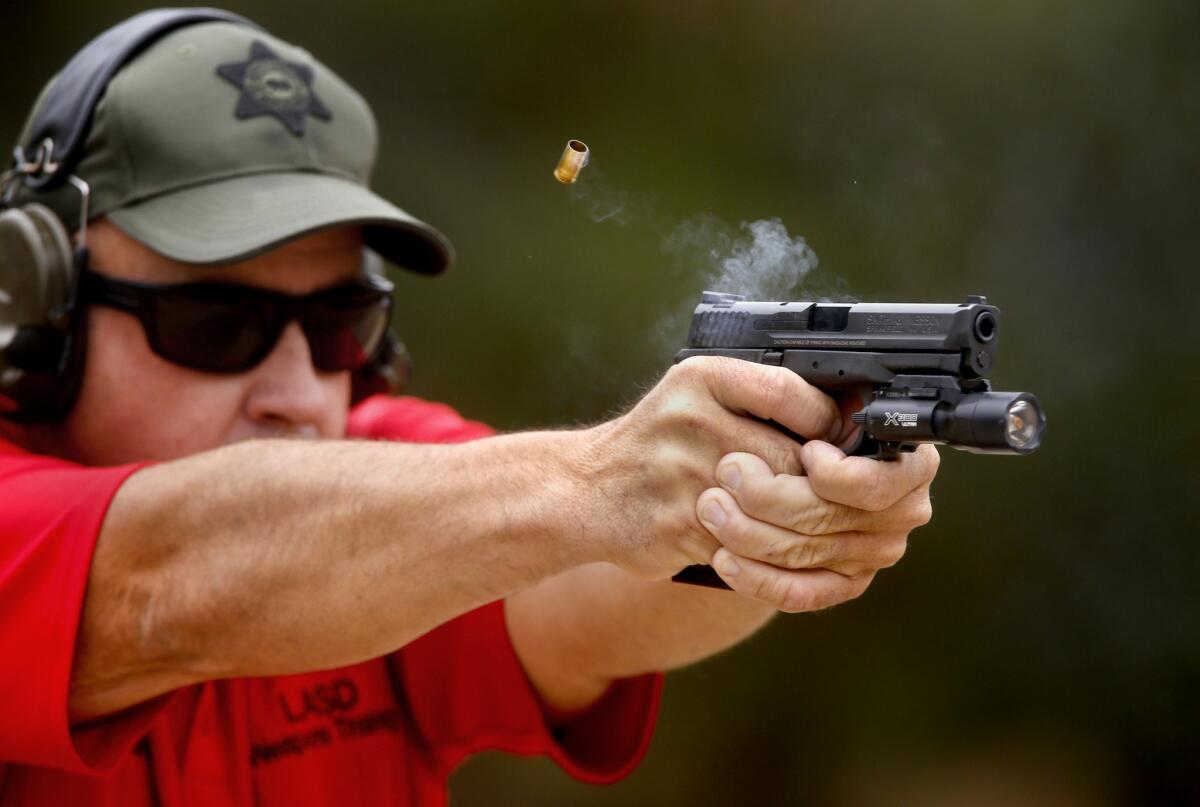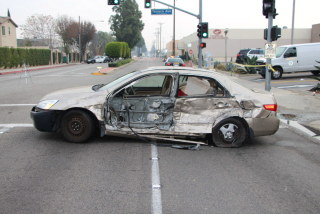Rise in accidental gunshots by L.A. County deputies follows new firearm

L.A. County Sheriff’s Department weapons training instructor Sgt. Mike Brandriff fires his Smith & Wesson at the Pitchess Detention Center gun range.
One sheriff’s deputy shot himself in the leg while pulling out his gun to confront a suspect.
Another accidentally fired a bullet in a restroom stall. A third deputy stumbled over a stroller in a closet as he was searching for a suspect, squeezing off a round that went through a wall and lodged in a piece of furniture in the next room.
Accidental gunshots by Los Angeles County sheriff’s deputies have more than doubled in two years, endangering bystanders and occasionally injuring deputies. The jump coincides with the department’s move to a new handgun that lacks a safety lever and requires less pressure to pull the trigger.
Sheriff’s officials say that the increase in accidental discharges — from 12 in 2012 to 30 last year — occurred because deputies were adjusting to the new gun. They expect the numbers to fall in the years ahead. So far this year, the department has recorded seven accidental discharges, five of which involved the new weapon.
But the problems may not be over, as more deputies switch to the Smith & Wesson M&P9. In response, department officials have imposed extra training requirements.
The M&P has obvious benefits. It is easier to shoot accurately, can be fired more reliably under stress and is a better fit for people with small hands. The switch was prompted in part by the threat of a lawsuit by women who had failed the Sheriff’s Academy. More recruits — including more women — are now passing the firearms test, and veteran deputies are also logging better scores at the firing range.
But the sharp increase in accidental discharges has prompted an investigation by the Sheriff’s Department’s new inspector general. Critics say this type of semiautomatic, which is widespread in law enforcement and includes the Glock used by many agencies, is too easy to misfire.
At the New York Police Department, a rookie officer is facing criminal charges, including negligent homicide, in a fatal shooting in a housing project stairwell. An attorney for the officer says he accidentally fired his department-issued Glock.
A former Los Angeles Police Department officer who was paralyzed when his 3-year-old son shot him with a Glock has sued the gun manufacturer and others, alleging that the light trigger pull and lack of a safety mechanism contributed to the accident.
Bob Owens, editor of BearingArms.com, says the design of the Glock and the M&P makes such tragedies more likely. “I don’t think, with the amount of training most agencies have, that a gun that has so few tolerances for mistakes is the best choice,” he said.
An adjustment
For two decades, L.A. County sheriff’s deputies carried the Beretta 92F, a heavy metal gun with a large grip.
People with small hands often have trouble flipping up the Beretta’s safety as they prepare to fire. The first shot requires 12 to 15 pounds of pressure on the trigger, forcing some to use two fingers and reducing shooting accuracy for many. Subsequent shots take about 4 pounds of pressure.
The M&P is made of lightweight polymer, with a hand grip that comes in three sizes. Firing a round is as simple as pulling the trigger with a consistent 6 to 8 pounds of pressure.
Sheriff’s deputies have the option of sticking with the Beretta, and some have, saying they are used to it. But many who have switched to the M&P say their shooting has improved.
“At first, I thought, ‘No way, I’m keeping my Beretta forever,’” said Sgt. Mike Rafter, a firearms instructor. “Then I started shooting, and it’s a lot nicer. I can shoot better, and I’m more confident.”
Academy trainees began receiving M&Ps in 2011 and the rest of the department began gradually switching to the new gun soon after. About half of sworn personnel are now using the M&P and more are changing over. As more deputies converted to the M&P, accidental discharges rose.
In 2012, there were 12 accidental discharges, none involving the M&P. In 2013, there were 18, eight of which were M&Ps. Of the 30 incidents in 2014, 22 involved M&Ps.
Assistant Sheriff Todd Rogers attributed the increase to deputies still adjusting to the lack of a safety on the new gun.
“The vast majority were people trained on the Beretta,” Rogers said. “There is a correlation, no doubt about it.”
A Beretta spokesperson did not return a phone call seeking comment. A spokesperson for Smith & Wesson said the company does not speak publicly about the weapons it supplies to law enforcement.
Accidents on duty
Many of the accidental M&P discharges in 2014 occurred while deputies were on duty, often on the street or in homes during searches. In one December incident, a sheriff’s deputy in Compton approached a car he thought might have been stolen. The occupants had already ran off. As he walked up with his M&P drawn to make sure there was no one else inside, he accidentally pulled the trigger.
The bullet hit the driver’s side door. There were bystanders nearby, but no one was injured.
A month earlier, a Lancaster deputy was following a driver he suspected of having a gun. When the man got out and walked toward the patrol car, the deputy took off his seat belt and was pulling out his M&P when he fired it into his own thigh. He was the only person injured that year, but in other cases, civilians or other deputies were nearby and could have been hit.
In a Walnut-area house in January 2014, a deputy accidentally fired a round into the ceiling when a golf bag fell on his hand. Another deputy was in the room at the time.
When a deputy tripped over a stroller and fired a round through a wall in October 2014, there was another deputy nearby, with more deputies and a civilian elsewhere in the Huntington Park house.
The NYPD custom-rigs its handguns with a heavier trigger pull to reduce the risk of accidents. Prosecutors argue that rookie Officer Peter Liang broke a key safety rule by resting his finger on the trigger of his Glock while patrolling a Brooklyn housing project on Nov. 20. As Liang pushed open a stairwell door, he fired a bullet that fatally struck Akai Gurley, 28, who was walking down the stairs. Liang’s attorney has said that his client shot the gun accidentally.
Shortly after the LAPD switched from Berettas to Glocks a decade ago, Officer Enrique Herrera Chavez was shot in the back by his 3-year-old son. Chavez was driving on July 10, 2006, when the boy found his father’s Glock under the vehicle’s center console and discharged a round, rendering Chavez a paraplegic.
Chavez’s lawsuit was dismissed in 2010, but an appeals court ruled that a jury should hear many of the former police officer’s arguments that the design of the Glock made it too easy for a small child to fire. A trial is scheduled for October.
‘Training scars’
L.A. County sheriff’s deputies learning to shoot the Beretta were taught to rest a finger on the trigger as soon as they took aim. The mantra was “on target, on trigger.”
With M&Ps and Glocks, the trigger finger should stay on the side of the gun until the last moment.
To combat the rise in accidental discharges, deputies are now required to pass a marksmanship test four times a year instead of three and to take a course designed to break old Beretta habits. Those who have accidentally discharged their weapons are typically required to repeat the training.
“We call them training scars,” Rogers said. “It’s muscle memory. And especially in stressful situations, people revert to their training.”
Richard Fairburn, a firearms expert who works for a law enforcement agency in Illinois, called the M&P a “more modern weapon” that enables more officers to shoot well. But, he said, the lighter trigger pull and lack of a safety could result in more accidental discharges if the new habits aren’t drummed into deputies through rigorous training.
“If you still have your finger on the trigger when you put it in your holster, you’ll end up with a stripe on your leg,” Fairburn said.
The LAPD recently began issuing M&Ps after using Glocks since 2005, said Lt. Dana Berns, who heads the firearms and tactics section. The department did not provide accidental discharge statistics in response to requests by The Times. But Berns said he did not believe the department had a problem when officers made the transition to the Glock, and none is expected with the M&P because it is similar to the Glock.
Unlike sheriff’s deputies, LAPD officers were trained to carry the Beretta with the safety off because flipping it was cumbersome and could result in the gun firing too late, or not firing at all, in dangerous situations.
The key to preventing accidental discharges is training, Berns said. The LAPD requires officers to pass six firearms tests a year, including one with a shotgun and one that simulates real-life scenarios.
“It seems as if the sheriffs are having a problem with training,” Berns said. “What you do subconsciously is a matter of training.”
Better test results
The M&P appears to have fulfilled its promise on one front: More women are making it into the department. The percentage of female recruits who failed the firearms test has plunged from 6.4% to less than 1%.
Pass rates are up across the board, not just for women. With the Beretta, more than 60% of trainees in one academy class needed extra firearms training. Ten out of 80 or so trainees in another class flunked because of the shooting test.
With the M&P, the class with the worst shooting results sent only 17% of trainees to remediation, and only three failed.
Susan Paolino, whose 1980 gender discrimination lawsuit against the Sheriff’s Department resulted in a landmark consent decree, said female deputies should be held to the same standards as men. But she supports new equipment that can help them meet those standards.
About 18% of sheriff’s deputies are women.
“If it’s something that’s not going to let them lower the standards, where they still have to have the skill but shoot better with a gun that fits their hand, that’s great,” Paolino said.
More to Read
Sign up for Essential California
The most important California stories and recommendations in your inbox every morning.
You may occasionally receive promotional content from the Los Angeles Times.











